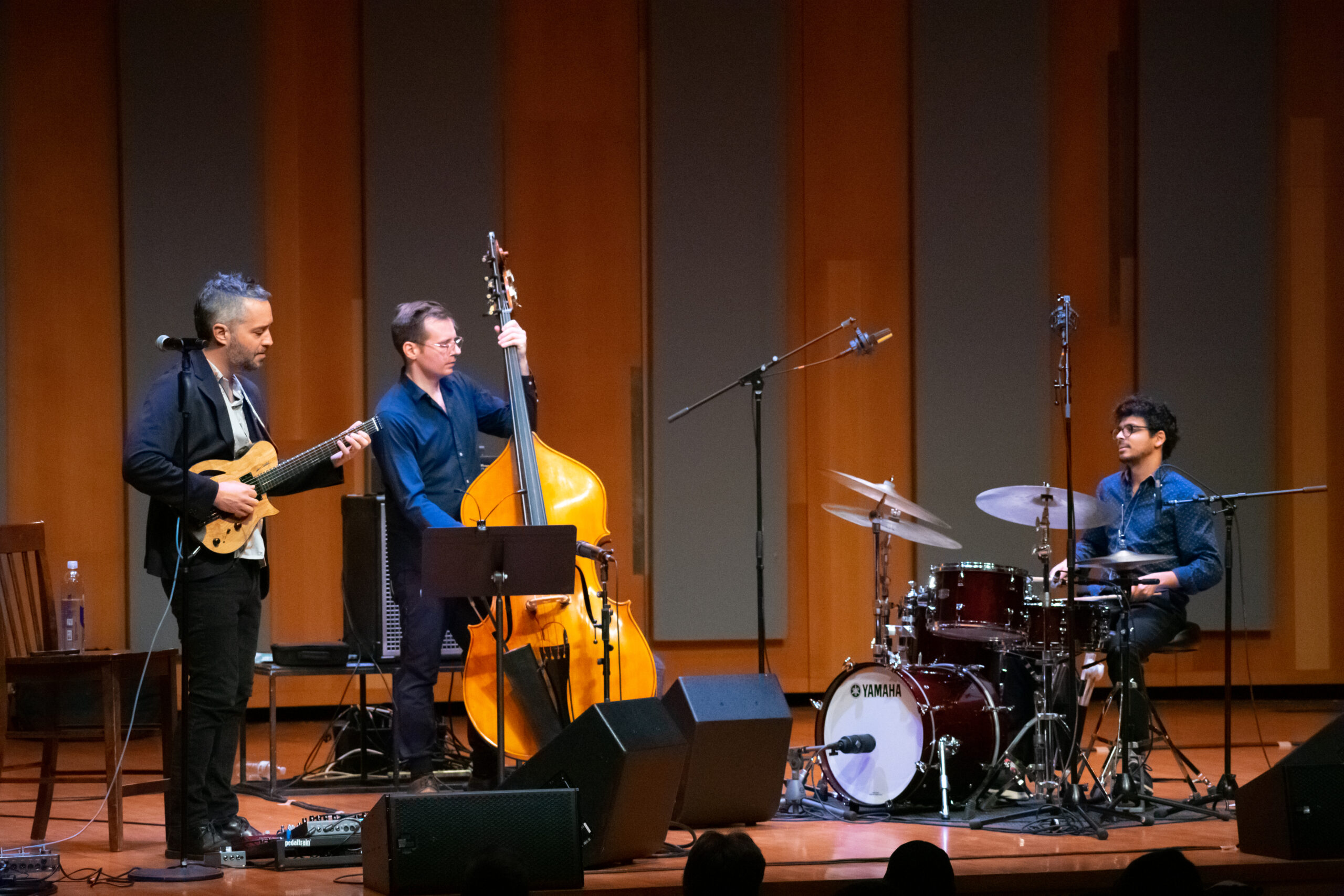Jazz legends inspire at Guitar, Bass & Drums Festival
The Russell/Wanlass Performance Hall came alive with the soothing sounds of jazz music on March 4 as part of Utah State University’s Guitar, Bass & Drums Festival.
The rhythmic beat of the drums and the low, swinging bass lines of the guitar permeated the air as attendees came to listen and learn from drummers Danny Gottlieb and Ofri Nehemya, bassists Mark Egan and Alexander Claffy and guitarist Yotam Silberstein.
“These are five of the top musicians in their field, many of them coming from New York City,” said Corey Christiansen, guitar program coordinator in the USU department of music.
The day-long festival featured a series of masterclasses, panels and workshops focused on musicianship, culminating in a final jazz concert.
“We had a drum, bass and guitar workshop and a couple of Q&A sessions,” Christiansen said. “The students really got incredible instruction from some of the best guys in the world.”
The festival began in 2018 when Christiansen sought to highlight instruments within jazz bands often go overlooked but are nonetheless crucial to the piece.
“When you have a jazz area of study at a university, the big band there will typically bring in guest artists and do something like this,” Christiansen said. “It’s really easy for a big band to bring in a saxophonist, a trumpeter or a trombonist because they fit in really well as a soloist, but the rhythm section often gets neglected.”
Alongside associate professor of professional practice Braun Khan and associate professor of percussion Jason Nicholson, Christiansen turned the festival into an annual tradition at USU.
“I thought this would be an incredible thing if we could start a festival just focused on the trio — the guitar, the bass and the drums,” Christiansen said. “We could bring in guest artists that could really help and inspire our students and show them what level they can attain when they put in the right kind of work.”
Bigger areas such as New Orleans and New York are entrenched in jazz and are often premier spots for aspiring jazz musicians. For cities like Logan where jazz is less popular, events like the festival are crucial to keeping the jazz scene alive.
“Sometimes being at a place like Logan — it’s different where you’re not near a metropolitan area,” Khan said. “Doing a festival like this gives us an opportunity to bring that jazz world to Logan and give students a chance to interact with these musicians where they might not otherwise be accessible.”
Jazz is considered difficult to define, in part because there are over 30 subgenres. Regardless, it has been recognized as a major and rich form of musical expression in traditional and popular music.
“I love everything about jazz,” Christiansen said. “I love the way the music feels, the pulse and rhythm of the music, the harmonies and the chord progressions. There’s an element of improvisation, and with improvisation, there’s an element of indeterminacy.”
According to Jazz Observer, jazz music originated in New Orleans in an area dubbed Congo Square — a place of reprieve where enslaved and free people of color could safely gather and engage in song and dance. Born from a blend of Creole culture, West African traditions and Cuban-style rhythms, jazz music would characterize the Roaring ‘20s with its lilting cadence and dynamic improvisations.
“Jazz is sometimes considered America’s classical music because it’s a uniquely American genre,” Khan said. “It’s one of the few styles that involves a lot of improvisation, and there’s something really natural about the idea of improvising.”
Jazz is often a blend of composed music and improvisation, creating entirely unique pieces of music driven by spontaneity and purpose. For Khan and Christiansen, jazz is similar to conversation.
“It’s kind of like the difference between having a conversation with somebody and giving a prepared speech,” Khan said. “There’s something much more organic about interacting in an impromptu conversation type of way, and jazz has that same format built into it.”
One of the main goals of the festival is to inspire attendees — especially students — through the musicianship of its guest artists.
“They’re seeing incredible musicians playing music they’re studying at the highest level,” Christiansen said. “Having guest artists on campus can give students a lot of hope. Every one of these musicians went to school for music, and students realize they’re on the same path that some of these heroes were on.”
According to Christiansen, mentorship and observation are one of the best ways for aspiring musicians to grow.
“Find older, experienced musicians and just learn everything you can from them,” Christiansen said. “Surround yourself always with people who have more experience than you and ask good questions.”
For educators and artists in the music industry, building a network and witnessing the musicality of others can make all the difference in booking the next gig or nailing the final measure.
“I also benefit just from learning from these guys who come in, no matter the genre,” Christiansen said. “As teachers and professors, we get a lot of benefit because we’re learning also.”
The connections formed at concerts and festivals such as these have forged a small yet tight-knit community in Logan with a shared passion for music and performance.
“The jazz world is not that big — the longer you’re in it, the more you realize you’re all connected in different ways,” Khan said. “It’s nice to be reminded of that broader sense of community we’re all a part of.”

